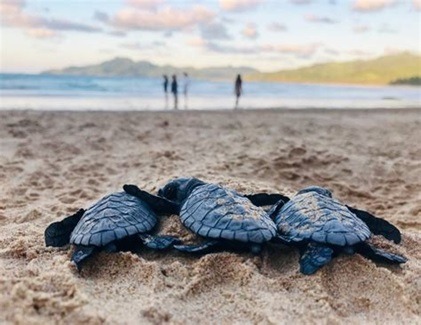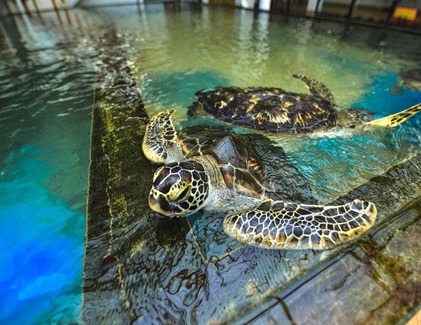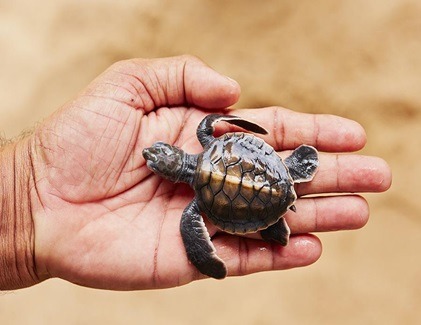Turtle Hatchery in
Sri Lanka –
Conservation Efforts to Save Sea Turtles
Sri Lanka is an island rich in biodiversity, with several species of sea turtles nesting along its sandy shores. To protect these endangered creatures, turtle hatchery Sri Lanka locations have been established along the coast. These hatcheries play a vital role in marine life conservation, education, and ecotourism, offering visitors a unique opportunity to witness and support efforts to safeguard sea turtles.
How Turtle Hatcheries Protect Endangered Sea Turtles in Sri Lanka
Sea turtles in Sri Lanka face many dangers, including habitat destruction, pollution, poaching, and the effects of climate change. To protect these endangered species, turtle hatcheries along Sri Lanka’s coastline collect eggs from vulnerable nesting beaches and incubate them in secure, controlled environments. After hatching, the baby turtles are safely released back into the ocean. These sea turtle conservation efforts improve hatchling survival rates and play a vital role in preserving Sri Lanka’s marine life. Visitors to these turtle hatchery centers can learn about the importance of protecting sea turtles and contribute to ongoing conservation programs.
Popular Sea Turtle Conservation Centers in Sri Lanka
Kosgoda Turtle Hatchery
Among the most famous turtle hatcheries in Sri Lanka, Kosgoda is dedicated to sea turtle protection and rehabilitation. Visitors can learn about various turtle species, observe baby turtles, and participate in hatchling releases during sunset, supporting important marine conservation efforts.
Bentota Turtle Hatchery
Situated along Sri Lanka’s southern coast, this hatchery rescues and nurtures injured turtles while conserving turtle eggs. It offers valuable insights into the sea turtle life cycle and the challenges these endangered creatures face in the wild.
Hikkaduwa Turtle Hatchery
This center combines conservation with care for injured and disabled turtles. Tourists have the chance to engage with conservationists, see turtles at different life stages, and contribute to rehabilitation programs.
Rekawa Turtle Conservation Project
Different from traditional hatcheries, Rekawa focuses on natural conservation by protecting nesting turtles in their original beach habitat. The project safeguards hatchlings from predators and poachers, promoting sustainable sea turtle conservation in Sri Lanka.

Sea Turtle Species Found Around Sri Lanka
Sri Lanka’s coastal waters are home to five of the world’s seven sea turtle species, making it a vital habitat for marine biodiversity and conservation efforts:
- Green Turtle (Chelonia mydas) – The most frequently nesting sea turtle species on Sri Lanka’s beaches, playing an important role in coastal ecosystems.
- Olive Ridley Turtle (Lepidochelys olivacea) – Known for nesting in large groups, this species is commonly spotted along Sri Lanka’s coastline during breeding season.
- Loggerhead Turtle (Caretta caretta) – Less commonly seen but present in Sri Lankan waters, these turtles contribute to the region’s diverse marine life.
- Hawksbill Turtle (Eretmochelys imbricata) – A critically endangered species prized for its striking shell, often threatened by illegal poaching.
- Leatherback Turtle (Dermochelys coriacea) – The largest sea turtle species, rarely nesting in Sri Lanka but occasionally observed offshore, highlighting the island’s rich marine diversity.

Best Time to Visit Turtle Hatcheries in Sri Lanka
The ideal time to visit a sea turtle hatchery in Sri Lanka is between November and April. During these months, nesting activity peaks along the southern and western coasts. Many conservation centers offer night tours to observe female turtles laying eggs. Early morning and evening visits let you watch hatchlings safely make their way to the ocean. Visiting during this turtle hatching season provides a rewarding experience for wildlife and marine life lovers alike.

How to Support Sea Turtle Conservation in Sri Lanka
- Visit responsible turtle hatcheries.
Choose ethical hatcheries in Sri Lanka that focus on sea turtle conservation and protect nesting sites. They follow eco-friendly practices for caring for and releasing hatchlings. - Respect nesting turtles.
During the turtle hatching season, avoid flash photography and loud noises at beaches. Keep a safe distance to prevent disturbing turtles. - Avoid turtle shell souvenirs.
Do not buy products made from turtle shells. These harm endangered species like the Hawksbill Turtle. Support conservation by choosing ethical local crafts. - Choose sustainable marine tourism.
Join guided turtle watching tours or educational programs at hatcheries in Kosgoda, Bentota, and Hikkaduwa. These promote awareness and protect marine life in Sri Lanka.
Turtle hatcheries in Sri Lanka play a vital role in protecting endangered sea turtles and preserving marine biodiversity.Visiting a coastal conservation center offers a meaningful, educational experience while supporting wildlife protection efforts.You can witness baby turtles being released into the ocean during specific seasons and times.These hatcheries also care for injured turtles and educate visitors on threats like pollution and illegal poaching.
Each activity contributes to sea turtle conservation and promotes responsible tourism in Sri Lanka.
Plan your visit to a turtle hatchery and help protect these incredible marine creatures for generations to come.
